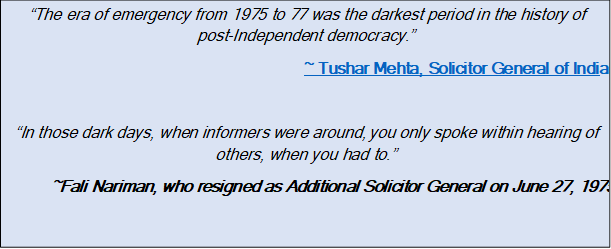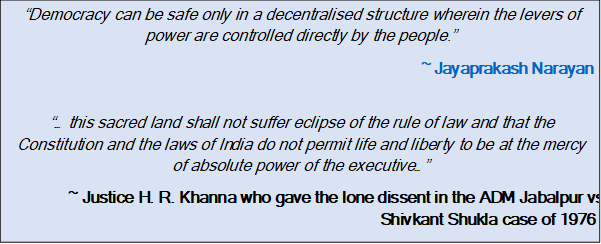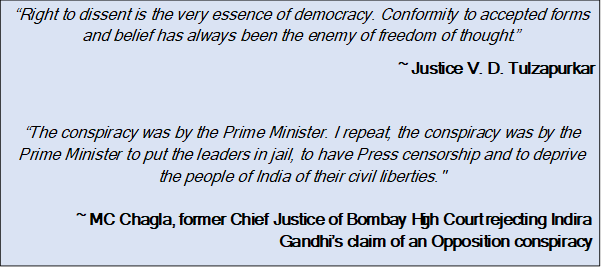Social Welfare
The Emergency in India
Posted On: 24 JUN 2025 14:36 PM
A timeline of legal and political actions during the Emergency
Between 25 June 1975 and 21 March 1977, India was placed under a state of Emergency under Article 352 of the Constitution.
Lead-Up to the Emergency
![Text Box: “No one, not even the Prime Minister, should be above the law of the land.”~ Morarji Desai“This [emergency] was the greatest assault on our Constitution.”~ Harish Salve, Former Solicitor General of India](https://static.pib.gov.in/WriteReadData/userfiles/image/image003R7EE.png)
The Emergency was declared in a backdrop of mounting political unrest and judicial developments that shook the legitimacy of the ruling leadership.
- In the early 1970s, opposition to the then government intensified. Protests led by Jayaprakash Narayan gained momentum in Bihar and Gujarat.
- Student-led agitations, unemployment, inflation, and perceptions of corruption fuelled dissatisfaction.
- On 12 June 1975, Justice Jagmohanlal Sinha of the Allahabad High Court ruled that the then Prime Minister Indira Gandhi had misused government machinery in her 1971 Lok Sabha election campaign.
- The court found her guilty under the Representation of the People Act, 1951 and disqualified her from holding any elected office for six years.
- The case had been filed by Raj Narain, the socialist leader who had lost to Ms. Gandhi in Rae Bareli. His legal challenge resulted in the landmark verdict.
- The Supreme Court granted a conditional stay. Ms. Gandhi could remain Prime Minister and attend Parliament but was barred from voting.
- The political crisis intensified, with demands for her resignation.
Declaration of Emergency

The formal declaration of Emergency marked a turning point in Indian constitutional history.
- On 25 June 1975, the then President Shri Fakhruddin Ali Ahmed issued the Emergency proclamation under Article 352, citing threats from internal disturbance.
- The decision followed a press note from the government accusing individuals, including Jayaprakash Narayan, of provoking the police and armed forces to defy orders.
- This was the third Emergency in India’s history, but the first one declared in peacetime. Earlier proclamations were during wars with China (1962) and Pakistan (1971).
- At that time, Article 352 allowed the President to declare Emergency on three grounds: war, external aggression, or internal disturbance.
- The phrase “internal disturbance” was used in place of what was later amended to “armed rebellion” through the 44th Constitutional Amendment in 1978.
- The executive acquired overriding powers, and state authority was brought under central control.
Legal Measures and Suspension of Rights

Following the proclamation, constitutional safeguards were systematically suspended.
- On 27 June 1975, Articles 358 and 359 were invoked.
- Article 358 suspended protections under Article 19, affecting freedom of speech, expression, assembly, and movement.
- Article 359 allowed the state to suspend enforcement of fundamental rights under Articles 14, 21, and 22, including equality before law, right to life and liberty, and protection against detention.
- Citizens were barred from approaching courts for redress.
- Opposition leaders including Jayaprakash Narayan, Morarji Desai, Atal Bihari Vajpayee, L.K. Advani, and others arrested under Maintenance of Internal Security Act (MISA).
- The Maintenance of Internal Security Act (MISA) was used extensively. Nearly 35,000 people were detained under preventive detention without trial, as per the Shah Commission.
Censorship and Media Control

The Emergency saw strict control over the press and public information through institutional mechanisms and administrative orders.
- From 26 June 1975, pre-censorship was imposed on all newspapers.
- Editors were required to get government clearance before publishing news, editorials, and photographs.
- The government appointed a national censor along with regional censors to monitor press content. Radio-photo transmissions were also brought under government clearance.
- On 5 July 1975, telex messages by foreign correspondents were restricted and subjected to prior screening.
- On 20 July 1975, the Board of Film Censors was restructured under the Cinematograph Act to tighten control over cinema.
- On 1 February 1976, the government merged four major news agencies namely Press Trust of India (PTI), United News of India (UNI), Samachar Bharati and Hindustan Samachar into a single entity named Samachar.
- The Press Council of India, a statutory watchdog, was abolished.
Legislative Amendments During the Emergency

Parliament passed a series of constitutional amendments during the Emergency that weakened judicial review and institutional checks.
- The 38th Amendment barred the courts from questioning the President’s decision to declare Emergency.
- The 39th Amendment excluded the election of the Prime Minister and Speaker of the Lok Sabha from judicial scrutiny.
- The 42nd Amendment further increased central powers. It gave primacy to Directive Principles over Fundamental Rights, barred judicial review of constitutional amendments, and curtailed the powers of the Supreme Court and High Courts.
- Through the 42nd Constitutional Amendment, the term of the Lok Sabha and State Legislative Assemblies was extended from five to six years.
Mass Sterilisation and Population Control Campaign
One of the most controversial aspects of the Emergency was the forced sterilisation campaign.
- The campaign began in 1975 as part of an intensified population control effort.
- A total of 26.42 lakh sterilisation procedures were conducted in 1975–76. In 1976–77, the number rose to 81.32 lakh.
- Over two years, 1.07 crore sterilisations were performed.
- Several states linked access to essential services with sterilisation. People were denied rations, housing, jobs, healthcare and loans if they had more than two or three children and refused to undergo the procedure.
End of Emergency

The Emergency came to a formal end in March 1977, following a political shift triggered by general elections.
- The Emergency was lifted on 21 March 1977.
- General elections to the Lok Sabha were held between 16 and 20 March 1977.
- The Congress party was defeated, and the Janata Party formed the government on 24 March 1977.
- The Shah Commission of Inquiry was set up in May 1977 to examine abuses of power during the Emergency.
- The 44th Constitutional Amendment was enacted in 1978.
- It replaced “internal disturbance” with “armed rebellion” as grounds for Emergency.
- It also restored judicial review and introduced legal safeguards for future proclamations.
Shah Commission of Inquiry
After the Emergency ended in March 1977, the government appointed a commission to examine its impact and the actions taken during the period.
- The Shah Commission of Inquiry was established in May 1977, headed by Justice J.C. Shah, former Chief Justice of India.
- Its mandate was to investigate excesses committed between 25 June 1975 and 21 March 1977.
- The Commission examined the misuse of government power, preventive detentions, press censorship, and the sterilisation campaign.
- It collected evidence through public hearings, testimonies, and official records.
- The Commission submitted three reports between 1978 and 1979.
- Detentions: As of 1 January 1975, Indian jails housed 2,20,146 prisoners against a capacity of 1,83,369. Among them, 1,26,772 were under-trial prisoners.
- Sterilisation Drive: Over 1.07 crore sterilisations were conducted nationwide during the Emergency. These included 548 complaints involving unmarried individuals and 1,774 reported deaths linked to the procedures.
- Forced Retirement: 25,962 government and public sector employees were retired prematurely during the period.
- Press Restrictions: Power supply to newspaper offices in Delhi was cut off during the early days of censorship enforcement.
- Content Control: Parliamentary and judicial proceedings were censored. Court judgements were edited or controlled in their published form.
- Media Classification: Newspapers were labelled as ‘friendly’, ‘neutral’ or ‘hostile’ based on their editorial stance and coverage.
Conclusion
The Emergency from June 1975 to March 1977 brought significant changes to India's constitutional, legal and administrative systems. Fundamental rights were suspended, preventive detentions increased, and restrictions were placed on the media. Constitutional amendments altered institutional powers. A large-scale sterilisation programme was implemented during this time. Following its withdrawal, an inquiry was set up and legal provisions were amended to regulate future use of Emergency powers.
Source: PIB Archives, Shah Commission of Inquiry (Third and Final Report)
The Emergency in India
***
Santosh Kumar/ Ritu Kataria/ Saurabh Kalia
Visitor Counter : 1